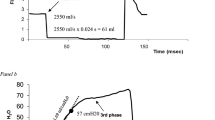Summary
We studied the effective site of an inhaled aerosol of procaterol, a β2-selective adrenergic bronchodilator, in 8 asthmatic patients whose basal lung functions are almost within the normal range in both slow vital capacity (VC) and forced expiratory volume in one second (FEV1.0), and are free from asthmatic attack. In patients who had received procaterol 30 min after inhalation of aerosol, there was no significant change in VC, although FEV1.0, maximal expiratory flow at 50% VC\((\dot V_{50} )\), maximal expiratory flow at 25% VC\((\dot V_{25} )\) and maximal expiratory flow at 30% VC of partial maximal expiratory flow volume curve\((\dot V_{30p} )\) improved significantly. On the other hand, in those who had received placebo, none of the parameters changed. Furthermore, Rl decreased and C0.5 increased significantly during the first 5 min after inhalation of procaterol aerosol. After an interval of 5 min, Rl did not change any further, while C0.5 continued to improve until 30 min after inhalation of procaterol. These results suggest that procaterol may first dilate the large airway and then may gradually dilate the small airway in bronchial asthma.
Similar content being viewed by others
References
Yabuuchi Y, Yamashita S, Tei S-S (1977) Pharmacological studies of OPC-2009. A newly synthesized selective beta adrenoceptor stimulant, in the bronchomotor and cardiovascular system of the anesthetized dog. J Pharmacol Exp Ther 202: 326–336
American Thoracic Society (1962) Definitions and classification of chronic bronchitis, asthma and pulmonary emphysema. Am Rev Respir Dis 82: 762–769
Swineford O Jr (1954) Asthma: classification of causes. A recommended classification and critical review. J Allergy Clin Immunol 25: 151–167
Takishima T, Sasaki T, Takahashi K, Sasaki H, Nakamura T (1972) Direct-writing recorder of the flow-volume curve and its clinical application. Chest 61: 262–266
Hida W, Arai M, Shindoh C, Liu YN, Sasaki H, Takishima T (1984) Effect of inspiratory flow rate on bronchomotor tone in normal and asthmatic subjects. Thorax 39: 86–92
Sasaki T, Suzuki S, Sugiyama M, Takishima T (1980) Frequency dependence of dynamic compliance analyzed from one cycle of breathing. J Appl Physiol 48: 45–53
Hilberman M, Stacy RW, Peter TM (1972) A phase method of calculating respiratory mechanics using a digital computer. J Appl Physiol 32: 535–541
Dennis MW, Douglas JS, Cashy JU, Stolwijk JAJ, Bouhuys A (1969) On-line analog computer for dynamic compliance and pulmonary resistance. J Appl Physiol 26: 248–252
Paré PD, Lawson LM, Brooks LA (1983) Patterns of response to inhaled bronchodilators in asthmatics. Am Rev Respir Dis 127: 680–685
Hida W, Sakurai M, Ichinose M, Shindoh C, Chonan T, Kikuchi Y, Inoue H, Takishima T (1985) Effect of Clenbuterol on peripheral airway obstruction in bronchial asthma. Curr Med Res Opin 9: 616–625
Fairster RD, Wilson AF (1980) Relationship between the site of airflow limitation and localization of the bronchodilator response in asthma. Am Rev Respir Dis 122: 27–32
Bames PJ, Basbaum CB, Nadel JA (1983) Autoradiographic localization of autonomic receptors in airway smooth musle. Marked differences between large and small airways. Am Rev Respir Dis 127: 758–762
Arai Y, Nitta K, Shida T (1985) Evaluation of procaterol aerosol as an aerosolized β2-adrenergic bronchodilators in conscious guinea pigs. Allergy 34: 999–1005
Kobayashi S, Yoshida T, Matsumura R, Kohei H (1985) Disposition of3H-fenoterol after inhalation in rats. Drug Res 35: 360–363
McFadden ER Jr, Newton-Howes J, Pride NB (1970) Acute effect of inhaled isoproterenol on the mechanical characteristics of the lungs in normal man. J Clin Invest 49: 779–790
Troyer AD, Yernault JC, Rodenstein D (1978) Influence of beta-2 agonist aerosol on pressure-volume characteristics of the lungs. Am Rev Respir Dis 118: 987–995
Bouhuys A, Van de Woestije, KP (1971) Mechanical consequences of airway smooth muscle relaxation. J Appl Physiol 30: 670–676
Woolcock AJ, Vincent NJ, Macklem PT (1969) Frequency dependence of Compliance as a Test for Obstruction in the Small Airway. J Clin Invest 48: 1097–1106
Author information
Authors and Affiliations
Rights and permissions
About this article
Cite this article
Taguchi, O., Hida, W., Nogami, H. et al. Possible site of bronchodilation due to inhaled procaterol aerosol in asthmatic patients. Eur J Clin Pharmacol 34, 433–437 (1988). https://doi.org/10.1007/BF01046698
Received:
Accepted:
Issue Date:
DOI: https://doi.org/10.1007/BF01046698




